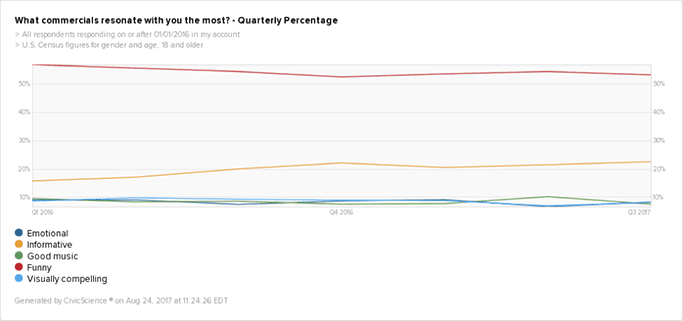Just when I thought our nation was irreparably fractured by socio-political division, we found two things in our data that united us all. From nearly every man, woman, and child staring in unison at the sun on Monday, to the near-universal mocking of ESPN’s reassignment of a football announcer because of his coincidental name, we saw consensus that has been unmatched as far back as we can remember. It may not be a sign of impending national unity but, hey, it’s a start.
With a relatively quiet week of business or media news, we spent most of our time looking at longer-term trends. Here are a few things we’re seeing:
Consumer confidence has barely budged. This is only interesting because of how uninteresting it is. Keep in mind that our most recent two-week reading encapsulated Charlottesville, the kind of event that has typically jolted economic sentiment over the past year. The fact that we’ve seen so little reaction in our numbers should be a positive sign.
Ad blocker usage continues to climb, particularly on mobile. This isn’t a pretty trend for media types – at least those that don’t have a strong subscription strategy. Consumers are getting both increasingly fed up with the current ad ecosystem and savvy in implementing solutions.
Here’s one chart, without further comment, that helps explain the rise of Netflix, Amazon, and food delivery; and the decline of physical retail, restaurants, and movie ticket sales:
Consumers are most influenced by different types of media at different times of the year. For my marketer friends, this might be the most important chart you’ll see in this email today. Notice a few things: First, the gap between TV advertising and social media is getting smaller and smaller. Second, TV ads and social media have been closest in parity during the third calendar quarter for three straight years – and the trend appears to be repeating in 2017. And third, Internet advertising has shown a steady, if modest climb since 2015. This seems counter-intuitive to our ad blocker data above, right? Maybe it’s simply consumers saying, yes, I’m seeing fewer online ads but the ones I am seeing are having a greater impact.
And what kinds of ads move the needle? Funny ones. If you want to produce branded content that resonates, comedy is king and that hasn’t changed much over time. But “informative” ads have risen as the most impactful from 16% to 23% since January of 2016. More and more people just want the facts. So, come up with a funny AND informative ad and you’ll have a blockbuster on your hands.
Random Stat (Trend) of the Week
Americans are becoming increasingly superstitious. In fact, people who say they are at least “Somewhat superstitious” have moved into the majority for the first time this year.
The number of Americans who are “Very Superstitious” has risen from 4% in 2013 to 7% in 2017, an increase of 75%.
And now you have Stevie Wonder stuck in your head, don’t you?
Hoping you’re well,
JD













